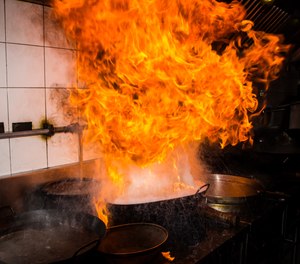How to put out a Grease Fire
Courtesy of FireRescue1 by Lexipol
A generous thank you to Captain Jeremy Francis and Firefighter Steven Malzachar from the Bismarck (North Dakota) Fire Department and Fire Chief Steve Nardello from the Mandan (North Dakota) Fire Department for their contributions to this article.
By Rikki Roehrich
Cooking causes over 160,000 home structure fires, annually, and is considered the number one cause of home fires and home injuries. Of the 160,000 annual cooking fires, two-thirds (66%) started with the ignition of food or other cooking materials. Often, these fires are ignited by grease.
In an effort to keep your home and community safe, please share these tips with friends and family. Knowing how to respond quickly could be the difference between a minor kitchen fire and a devastating disaster.
IF A GREASE FIRE STARTS:
- Cover the flames with a metal lid or cookie sheet. Leave the cover on until it has cooled.
- Turn off the heat source.
- If it’s small and manageable, pour baking soda or salt on it to smother the fire.
- As a last resort, spray the fire with a Class B dry chemical fire extinguisher.
- Do not try to extinguish the fire with water.
- Do not attempt to move the pot or pan outside.
Do not use flour, baking powder or other cooking powders that resemble baking soda or salt – they have a different chemical makeup and will not react similarly. They will make the fire worse.
It’s also important to remember that three out of five non-fatal home cooking fire injuries occurred when the victim tried to fight the fire themselves. The most common injuries sustained were burns to the hands and lower arms.
IF YOU ARE UNABLE TO EXTINGUISH THE GREASE FIRE:
- GET OUT! You and your family members need to leave as soon as you can to prevent injury or loss of life. Do not try to be a hero.
- Close the door as you leave to help contain the fire.
- Call 911 as soon as you are at a safe distance from the fire.
- Do not re-enter your home until the fire has been contained by firefighters.
While it is important to remember these steps in order to take appropriate action during a grease fire, it’s equally important to take actions to prevent them from occurring in the first place.
TIPS TO PREVENT GREASE FIRES:
- Stay in the kitchen while you are frying, grilling, boiling or broiling food. The leading cause of fires in the kitchen is unattended cooking.
- Be alert and do not use the stove or stovetop if you are sleepy or have consumed alcohol.
- Keep anything that can catch fire away from your stovetop.
- Remove as much moisture as possible from the food before putting it in hot oil. Do not put frozen foods into hot grease.
- Keep the grease at the recommended temperature. If you see any smoke or the oil smells, it is an indication that it is too hot. Immediately turn off the burner to let it cool down.
- Heat the oil slowly.
- Add food gently to prevent splatter.
- Keep a lid near the pan you're cooking with so that it is accessible if a fire starts.
- Always keep children away from the stove while cooking.
By using proper cooking techniques and best practices, frying with grease or oil should pose a relatively small risk. Still, it’s always good to keep this information nearby in the event you do experience a grease fire. A quick and proper reaction will minimize any damage as well as prevent injury and death.
Put a Lid on it!! Video demonstration.
